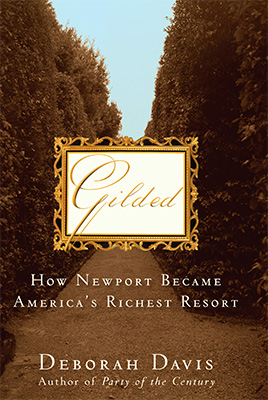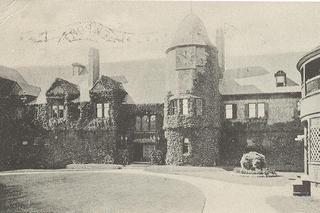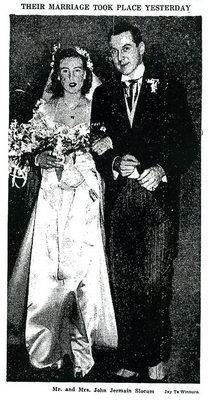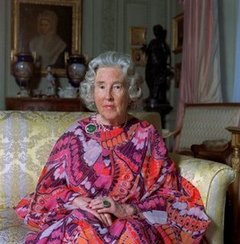Having met some of the same challenging residents she has, examining Deborah Davis' breathless, bright and entertaining new book, Gilded, How Newport Became America's Richest Resort, it's impossible not to be sympathetic. Here as nowhere else in the country, devoid of an ample fortune and an impeccable pedigree, one is made to feel a complete outsider. Neither in the Hamptons nor at Santa Barbara is one's alienation so complete. This isn't to say that some locals mightn't kindly deign to speak with or even to entertain one.

No, quite the contrary. Nevertheless, it would be foolish to presume that talent or charm alone might overcome one's status as an outsider.

It's failing to accept the autocratic inconsistency of Newport society that most mars Ms. Davis' spritely narrative. What a feat she has accomplished! In a scant 309 pages she leads the reader on a whirlwind tour through an opulent 'land of Oz'. Covering three centuries, Davis touches on nearly all Newport's most memorable bons mots. Some writers expending three times as many pages, could never have managed to produce as comprehensive or compelling a treatise on elite living. Yet one nonetheless regrets the small amount of added information that would have made Gilded even more lucid. If with her earlier engaging efforts, such as Strapless, devoted to a single Sargent portrait, thoroughness was a major strength, in Gilded, telling of the late Eileen Slocum for instance, Davis seems merely to have scratched the surface.
Examining the rich and full life of Newport's premier society hostess, the Republican National Committee powerhouse, Eileen S. S. Gillespie Slocum, one thing becomes perfectly clear. Compared with most people, to an inordinate extent, Mrs. Slocum's identity was intimately connected, over a long and eventful life, to all the posh places where she resided. Yet whatever she did, wherever she traveled, she refused to be unduly influenced by the unpleasant changes that had helped to transform New York, Washington or even Tuxedo Park, into very different and more chaotic places than they were when she was a girl. Mrs. Slocum persisted in reflecting a standard and a manner, most associated with her lifelong summer home by the sea.
Observing all the old rituals, Eileen Gillespie made her debut at a dinner dance. It was given by her family in 1933 at the five-year-old Hotel Pierre. Already, the imposing Grand Army Plaza district where her Grandmother Sherman's city house was located, had lost its two most impressive dwellings. Across 65th Street from Mrs. Sherman was Mrs. Astor's house.
Famously boasting a combination art gallery-ballroom, just large enough to hold New York society's 400 select members, in 1925 it was reluctantly demolished by her grandson, Vincent Astor. It was replaced by the city's most prominent synagogue, Temple Emanuel.
A year later, the long widowed Mrs. Cornelius Vanderbilt, II, abandoned at last her splendid
chateau occupying an entire block, between 57th and 58th Streets. Watching her elaborate home give way to the Bergdorf Goodman Building, she too had regrets.
By distinction, Mrs. William Watts Sherman, even against inevitability, would remain steadfast. Not until three years after her death, was her house, at 838 Fifth Avenue demolished, in 1950. What made its survival all the more remarkable, is that for the last twenty years of her life, Mrs. Sherman was a year-round resident of Newport, in her olde-English style house on Shepard Avenue.
Notwithstanding an impervious air of continuity, Newport was also dramatically evolving. Hoping to rule over Newport, unexpectedly, in 1915, Mrs. Stuyvesant Fish of Crossways,
died. Slightly earlier, her lieutenants, Harry and Elizabeth Lehr, moved to Paris. Mrs. Fish was succeeded, in time, by the imperious Mrs. James Laurens Van Alen of Wakehurst.
Mrs. Van Alen was rumored to be her Uncle Frederick Vanderbilt's mistress. Bypassing other relatives he left her $ 10 million in his will.
By the 1920's, even at Newport, many genteel young ladies from the 'best' families openly smoked in public. Once the focus of fashion in the summer colony, apart from tennis week at


the close of each season, the Casino grew less and less important, compared to the Clambake Club and Whitney Warren's Newport Country Club.
Over successive generations, from its lacey gates to its marble halls, right down to a warren of attic rooms, Mrs. Slocum's Victorian house at Newport, instead of being injuriously altered or materially diminished, unfolded, ever more beautifully, like a flower.
Not a natural flower mind you, one that fades, withers and dies, but one periodically, augmented by inheritance, that was expertly renewed and dutifully restored.

This house remains Mrs. Slocum's most memorable portrait. One is reminded of Edith Wharton's house, from her story, The Fullness of Life, a house with many rooms, filled with people and vitality, except for the private, lonely, innermost-sanctuary, the place where no one comes, at its heart.
For its proud mistress, at least, there were no lonely rooms whatever at 459 Bellevue Avenue. A stony medieval-inspired fortress on the outside, with an opulent neo-classical décor, by Ogden Codman, the house that she inherited, was always kept by Mrs. Slocum, by her mother and by her aunt, deliberately overflowing, season after season, with family and friends, with festivity, fun and purpose.
In far away England, at Henley-on-Thames, Oxfordshire, at Stonor Park, the situation was not as bright for Lady Camoys, Mrs. Slocum's mother's younger sister. Certainly the Brown millions came in handy in providing for renovations to the baron's eight-century-old manor house, along with electric lights, central heating and bathrooms. As they also summered at
Newport each year, beginning in infancy, Mrs. Slocum grew quite close to her English cousins.
Moderately rich, allied with one of England's most venerable noble dynasties, as well as several of Newport's and New York's notable families; the Wetmores, the Browns and Drexels, the Gillespies, were received everywhere and widely well regarded. If the Great Depression strained even the immense Brown family fortune, the far more modest means of Eileen Gillespie's father, like those of so many others, were severely tested now. Even so, considering matrimony, Lawrence Lewis Gillespie's heiress daughters, could afford to be less mercenary than many patrician girls.
In a clannish community like Newport, a suitor from a family as prominent as the Astors, even today, would always be considered by many, to be a sterling catch. Yet, in some less tumultuous time, a willfully spoiled and indolent character like 'Jack Astor', Vincent Astor's half-brother, John Jacob Astor, V, born after their father went down on the Titanic, even with a $3 million trust fund, would cause one to think twice. Just seventeen, at the time of her engagement to the 'boy next door', who lived across Sixty-Fifth Street from her Grandmamma Sherman, young Eileen Gillespie was bedazzled, at first!
It's pretty evident that today the cost of everything has become grossly inflated, with the average Manhattan apartment costing one and a half million dollars, as many New York school teachers expend as much in a month, as did some millionaires in the 1930's. In the late 1920's, outside of the Fifth Avenue shopping center growing below 59th Street, the grandest New York mansion could be obtained for $500, 000 or less. It's difficult indeed to grasp the relative and greatly increased purchasing power of money during Great Depression days. But it meant in effect, with an annual income of just under $200,000, when he came of age in 1933, John Jacob Astor, V was able to live in a way that, in the halcyon 1920's, would have demanded ten times as much!
Requiring, as a married man, a city address equal to his status as an Astor, on 91st Street, Eileen Gillespie's prospective husband had been able to lease the enormous, fully furnished Burden house, and to staff it with 25 servants, at around $15,000 a year. For summers, at Newport, one of Horace Trumbauer's most lovely 'cottages', Chetwolde, was purchased. Again, completely and exquisitely furnished, it was sold by Mrs. William Storrs Wells, for a mere $150,000.

A fleet of ten cars, including a yellow Brewster-bodied Rolls Royce, a private railway car and a steam yacht each followed. Along with this outpouring from Astor's cornucopia came a proposed wedding present for his fiancée, of a $1,500,000 trust fund, in lieu of dower rights. After protest from her parents as to its excessive generosity, this instrument was reduced by two-thirds.
Eileen Slocum's engagement ring was an Astor heirloom, reportedly worth $100,000. Previously, it had belonged to the consort of Napoleon III, the Empress Eugenie.
He was tall, tanned and good looking, as well as rich. But the daunting and unavoidable issue seems to have been that Jack Astor was unbalanced. Even today, amidst swirls of speculation, no one seems to know absolutely what precipitated Mrs. Slocum's canceled engagement. It happened mere days before her scheduled wedding. Whatever it was, it must have been sensational. From what other motivation do well mannered, reticent WASP families, people like the Gillespies, discuss private family matters, publicly and in the New York Times?
However unsure the press might have been as to the full story, they had had a field-day anyway. Innuendo and recriminations abounded, concerning everything from Astor's letter of apology to the fate of his fabulous ring. So it was that ordinary people, being ground into the dust by desperate times, were kept distracted from hunger, misery and fear, for days on end. The level of widespread public interest Mrs. Slocum's broken engagement drew, today would surely require the most outlandish antics of Madonna, Paris Hilton, some sports hero or the Obamas. Such was the intensified star-power of socialites, that Miss Eileen Gillespie's and Mr. John J. Astor's tame foibles had helped to sell dozens of daily newspapers in hundreds of extra editions to tens of thousands, eager, for five cents, to be thrilled vicariously, to the core of their being.
Initially subject to dispute, the diamond ring, ironically, went to Eileen Gillespie's best friend.
At Newport's historic Trinity Church, Ellen Tuck French, who was to have been a bride's maid at Eileen Gillespies betrothal, ended up as the first of Jack Astor's three wives.
Much transpired in the aftermath of Mrs. Slocum's big break-up with Astor so long ago. Not

the least occurrence was her happy union with John Jermaine Slocum in 1940. Occurring only a few years after the death of her sister Doris Beryl Gillespie, and within nine months of her father's sudden loss, their wedding took place in her mother's drawing room, at 11 East 89th Street.
A literary agent and a protégé of his Harvard classmate, David Rockefeller, John Slocum started out assisting New York Mayor Fiorello La Guardia. He was to go on to become an Office of Strategic Services officer and a diplomat, posted to both Germany and Egypt, among other missions. Slocum was, as well, a connoisseur of coins and of modern literature and a friend and patron of writers, including Henry Miller and Gertrude Stein.
The Slocums were married for over fifty years. They were attractive and attracting opposites, complementing their partner's gifts and the one fulfilling most deficiencies of the other. Eileen's talent for entertaining, for engaging strangers, balanced her husband's prestigious career with a brilliant kind of a-symmetry. Seemingly roaming the earth, the Slocums and each of their three children, instinctually, have always returned to Newport.
Host to an international throng of literally thousands of guest, even now, they share a time-honored graciousness, a thoroughly all-American type of hospitality, that Eileen Slocum made her life's chief endeavor. Relying on past successes and working quite tirelessly ahead of time, the sense of well-being she produced with lively conversation, good food and drink, flawlessly served, in an exquisite setting, seemed, as she intended, always to take no effort at all! Indisputably a worthy undertaking, Gilded, How Newport Became America's Richest Resort, for all its fascination, fails to live up to Mrs. Slocum's standard of effortless-seeming excellence.
